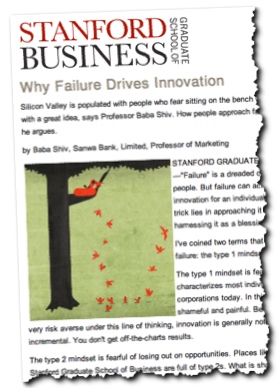 The world is full of paradox, like this one. Here’s research on startup vision that shows “The tech landscape is lush with entrepreneurs whose success blossomed only after the founders had modified or even abandoned their original vision.” That makes sense when you see examples and details. But wait – what about the idea that the best startups are driven by clear vision? Doesn”t the one contract the other?
The world is full of paradox, like this one. Here’s research on startup vision that shows “The tech landscape is lush with entrepreneurs whose success blossomed only after the founders had modified or even abandoned their original vision.” That makes sense when you see examples and details. But wait – what about the idea that the best startups are driven by clear vision? Doesn”t the one contract the other?
That’s business. Hard and fast rules don’t work often enough. You can’t just follow lists of best practices.
The thought comes from reading The Risk of an Unwavering Vision | Stanford Graduate School of Business. That piece summarizes research by William P. Barnett, a professor of business leadership, strategy, and organizations at Stanford’s Graduate School of Business; co-authored with colleague Elizabeth G. Pontikes of the University of Chicago. They decided to gauge entrepreneurial success rates by researching the early choices made by software entrepreneurs operating in 4,566 organizations in 456 different market categories over 12 years.
Successful founders change the startup vision
For example (quoting from the article above, describing the research) …
“Facebook became something quite different from the Harvard-specific social connection site created by Mark Zuckerberg. Airbnb? That short-term housing rental juggernaut started as a way for people to find roommates. What eventually became the ride-sharing app Lyft originally offered carpooling software for large companies.”
Barnett adds
“It’s almost always the case that the greatest firms are discovered and not planned.”
Following the crowd doesn’t often work
The post highlights Barnett saying:
“If you want to find a unicorn, listen for the buzz and run the other way.”
And adds the details:
“Barnett and Pontikes found that entrepreneurs who were willing to adapt their vision and products to find the right market often did the best. They also found that those who followed the herd into perceived hot markets, or “consensus” entrants, were less viable in the long run than those who made “non-consensus” choices by defying common wisdom and entering markets that were tainted by failures and thus regarded as riskier.”
Why is this paradoxical?
But wait. Doesn’t vision drive most successful companies? I’ve written in this space about what I call values, which are related to vision, with the idea that clear and consistent values can drive success. For example, from an older post here titled Build a Mission:
… you and I know companies … driven by missions. People can believe in a mission. It gives the team power and momentum. People are happier when they work on something they believe does some good to somebody.
So my conclusion is – and I’ve written this previously – there is no such thing as universal best practices. It’s all case by case.
 The prestige of the MBA degree is tarnished quite a bit since I got mine in the early 1980s. And that’s for pretty good reasons. With the world of startups like it is, and the progress of high tech, there are some good arguments against stopping a career for two years to go back to school. Still, my two years with the MBA were the right thing for me, for my family, and for my entrepreneurship. Everything is case by case.
The prestige of the MBA degree is tarnished quite a bit since I got mine in the early 1980s. And that’s for pretty good reasons. With the world of startups like it is, and the progress of high tech, there are some good arguments against stopping a career for two years to go back to school. Still, my two years with the MBA were the right thing for me, for my family, and for my entrepreneurship. Everything is case by case.
 I just ran across
I just ran across 

You must be logged in to post a comment.